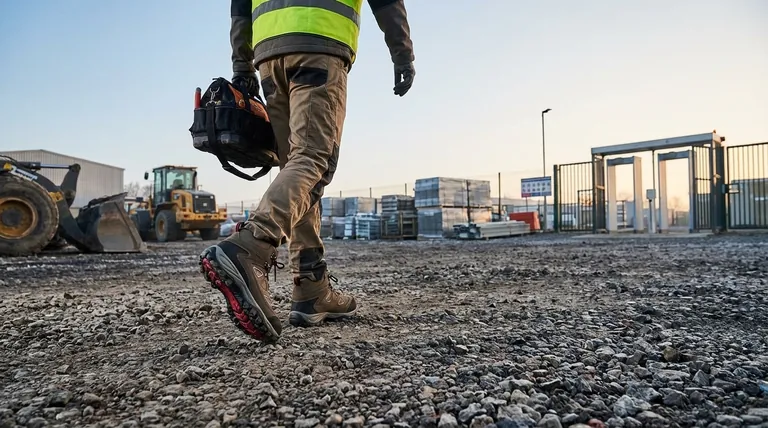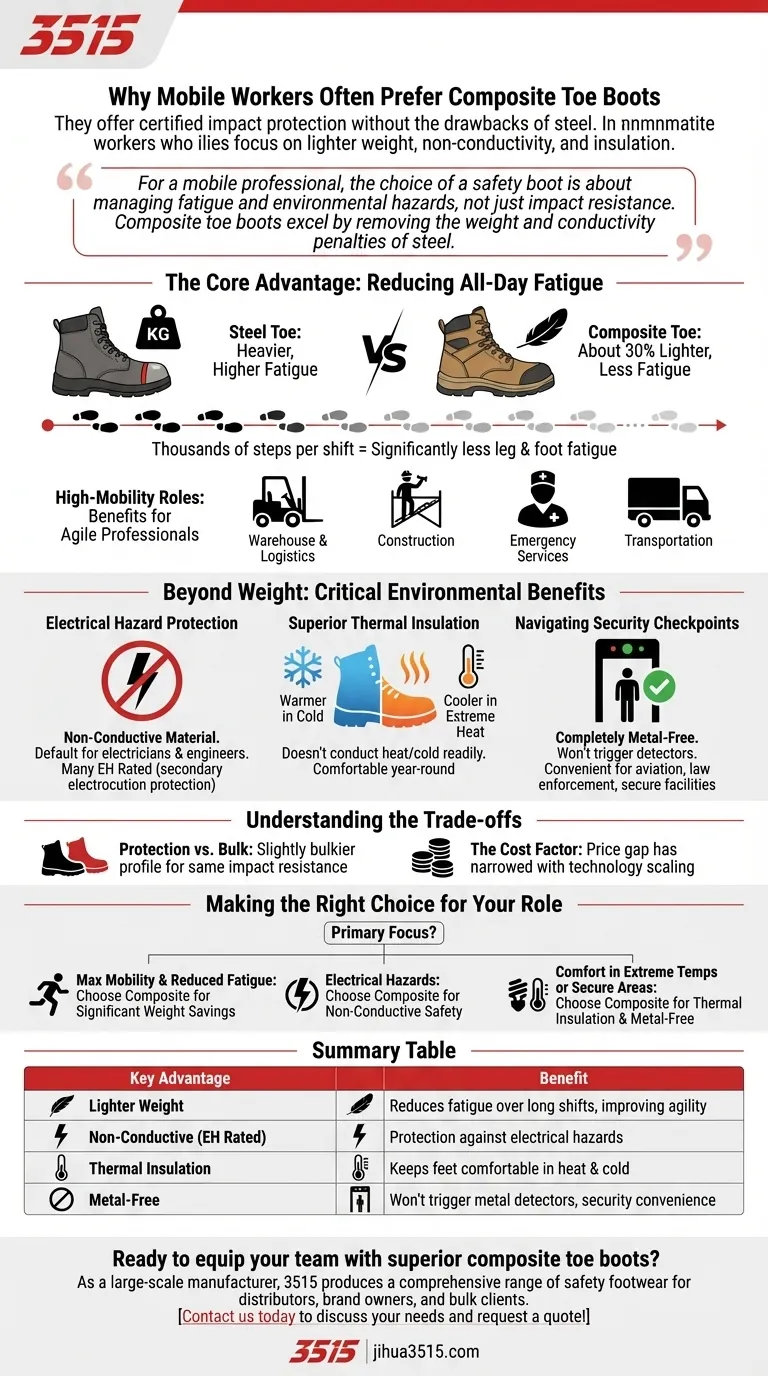Mobile workers often prefer composite toe boots because they deliver certified impact protection without the inherent drawbacks of traditional steel toes. The primary drivers for this preference are their significantly lighter weight, lack of electrical conductivity, and superior insulation against extreme temperatures, directly addressing the daily challenges of professionals on the move.
For a mobile professional, the choice of a safety boot is about managing fatigue and environmental hazards, not just impact resistance. Composite toe boots excel by removing the weight and conductivity penalties of steel, directly benefiting workers who cover significant ground or work in specialized environments.

The Core Advantage: Reducing All-Day Fatigue
For any worker who spends the majority of their day standing, walking, or climbing, the physical toll of their gear is a critical factor. The design of composite toe boots directly confronts this issue.
How Lighter Weight Impacts Your Day
The most immediate benefit of a composite toe is its reduced weight. A composite safety cap is typically about 30 percent lighter than a comparable steel one.
While this may seem minor for a single step, the effect compounds dramatically over thousands of steps taken during a full shift, leading to noticeably less leg and foot fatigue.
The Benefit for High-Mobility Roles
This weight reduction is especially valuable in roles that demand constant movement. Professionals in warehouse and logistics, construction, emergency services, and transportation find that lighter boots improve agility and reduce the overall physical burden of their work.
Beyond Weight: Critical Environmental Benefits
While weight is a major factor, the material properties of composites offer distinct advantages that are essential in many modern work environments.
Electrical Hazard Protection
Composite materials are non-conductive. This makes them the default choice for electricians, engineers, and anyone working in environments with a risk of live electrical currents.
Many composite toe boots carry an Electrical Hazard (EH) rating, certifying they provide a secondary source of protection against electrocution.
Superior Thermal Insulation
Unlike metal, composite materials do not readily conduct heat or cold. This means they offer far better insulation from the ambient temperature.
In cold weather, your feet stay warmer, and in extreme heat, the boot's toe box won't transfer scorching temperatures from the ground. This makes them more comfortable for year-round outdoor work.
Navigating Security Checkpoints
Because they are completely metal-free, composite toe boots will not trigger metal detectors. This is a significant convenience for workers in aviation, law enforcement, or at secure industrial facilities who must pass through security screening multiple times a day.
Understanding the Trade-offs
No single material is perfect for every situation. Being an informed professional means understanding the limitations and compromises of your equipment.
Protection vs. Bulk
While composite toe caps meet the same ANSI/ASTM safety standards as steel toes, they often need to be slightly bulkier to provide the same level of impact resistance. This can sometimes result in a slightly larger toe box profile.
The Cost Factor
Historically, composite toe boots were a more expensive option. However, as the technology has become more widespread and manufacturing has scaled, the price difference has narrowed considerably, making them a much more accessible choice.
Making the Right Choice for Your Role
Selecting the right safety boot requires matching its features to the primary demands of your job.
- If your primary focus is maximum mobility and reduced fatigue: The significant weight savings of composite toe boots is their single greatest advantage for all-day comfort.
- If your primary focus is working around electrical hazards: The non-conductive nature of composite materials is a non-negotiable safety feature.
- If your primary focus is comfort in extreme temperatures or passing through secure areas: The thermal insulation and metal-free design of composite boots are the superior choice.
Ultimately, choosing the right safety boot means matching its specific material advantages to the unique demands of your workday.
Summary Table:
| Key Advantage | Benefit for Mobile Workers |
|---|---|
| Lighter Weight | Reduces leg and foot fatigue over long shifts, improving agility. |
| Non-Conductive (EH Rated) | Provides protection against electrical hazards, essential for electricians and engineers. |
| Thermal Insulation | Keeps feet warmer in cold and cooler in heat, ideal for outdoor work. |
| Metal-Free | Won't trigger metal detectors, a major convenience for security-sensitive jobs. |
Ready to equip your team with superior composite toe boots?
As a large-scale manufacturer, 3515 produces a comprehensive range of safety footwear for distributors, brand owners, and bulk clients. Our production capabilities encompass all types of composite toe boots designed for the high demands of mobile professionals.
We can help you provide footwear that enhances worker comfort, safety, and productivity. Contact us today to discuss your needs and request a quote!
Visual Guide

Related Products
- Safety Footwear Wholesale Manufacturer for Custom OEM/ODM Production
- Custom OEM Training Shoes Wholesale Manufacturer Durable & Breathable
- Durable Moc-Toe Wedge Work Boots | Wholesale Manufacturing for Brands
- Durable Rubber Sole Outdoor Shoes Wholesale & Custom Manufacturing
- Wholesale Safety Footwear Manufacturer for Bulk & Custom OEM Orders
People Also Ask
- Do snake bite boots work? Your Ultimate Guide to Effective Snake Bite Protection
- What are OSHA approved shoes? Understanding the Correct Standards for Workplace Safety
- Is it normal to wear shoes in the house? A Guide to Hygiene, Comfort & Culture
- What cultural and environmental considerations are tied to wearing shoes indoors? Balance Hygiene, Tradition, and Foot Health
- How long can you wear safety boots? The Lifespan is Determined by Wear, Not Time



















